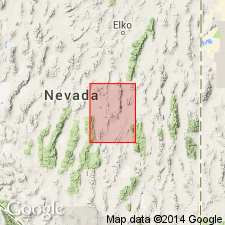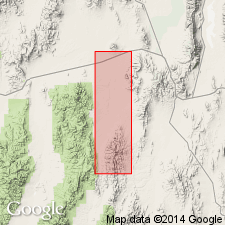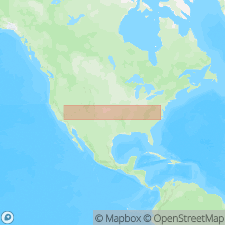
- Usage in publication:
-
- Copenhagen formation*
- Modifications:
-
- Areal extent
- AAPG geologic province:
-
- Great Basin province
Summary:
Pg. 28. Copenhagen formation. Overlies Antelope Valley limestone (new) in Antelope Valley, northeastern Nevada. Name credited to C.W. Merriam (unpub. ms.) [USGS Prof. Paper 423, 1963]. Age is Middle Ordovician.
Probably named for occurrence in Copenhagen Canyon, in Monitor Range, Eureka County. Well exposed on west face of Antelope Range, across valley and on the east, and about seven-eights of a mile south of Eureka County line.
Source: US geologic names lexicon (USGS Bull. 1200, p. 931).

- Usage in publication:
-
- Copenhagen formation*
- Modifications:
-
- Principal reference
- Biostratigraphic dating
- AAPG geologic province:
-
- Great Basin province
Summary:
Pg. 25-27, 28 (fig. 7), pl. 2 (geol. map). Copenhagen formation. Richly fossiliferous limestone, siltstone, and sandstone. Thickness 350 feet at Martin Ridge. Subdivided into informal members A, B, and C. Underlies Eureka quartzite and overlies Antelope Valley limestone of Pogonip group. Not present in Eureka district, thus is excluded from Pogonip group. Restricted to vicinity of Antelope Valley and is possibly a restricted depositional facies occupying time-stratigraphic interval of at least lower brown part [exposed elsewhere] of Eureka quartzite. Fossils [listed]. Is younger than ANOMALORTHIS brachiopod zone [Chazyan] of uppermost Antelope Valley limestone. May be as young as middle Trenton based on brachiopod studies of G.A. Cooper, 1956 (Smithsonian Misc. Colln., v. 127, pts. 1, 2); [see also Chart 2. Corr. Ordovician Fms. of North Amer. by W.H. Twenhofel and others, 1954, GSA Bull., v. 65]. Collections from members B and C include notable brachiopods REUSCHELLA VESPERTINA Cooper, ROSTRICELLULA ANGULATA Cooper, SOWERBYITES LAMELLOSUS Cooper, and VALCOUREA PLANA Cooper. Age is considered Middle Ordovician.
[Principal reference section]: west side of Martin Ridge, 1 mi southeast of union of Ryegrass Canyon with Copenhagen Canyon (pl. 2, loc. 10), [Horse Heaven Mountain 15-min quadrangle, Eureka Co., Toiyabe National Forest, central Nevada].
Source: Publication.

- Usage in publication:
-
- Copenhagen Formation*
- Modifications:
-
- Age modified
- Biostratigraphic dating
- AAPG geologic province:
-
- Great Basin province
Summary:
Pg. 1554, 1556-1557, 1560 (fig. 7). Copenhagen Formation. In hill 8308 section, Antelope Range, Nevada, key conodont zonal index fossils include (ascending) CAHABAGNATHUS SWEETI, PYGODUS ANSERINUS, EOPLACOGNATHUS ELONGATUS, BALTONIODUS GERDAE, PHRAGMODUS UNDATUS, and PHRAGMODUS TENUIS. Member A lies within Darriwilian CAHABAGNATHUS SWEETI zone (PYGODUS ANSERINUS subzone); members B and C range from Darriwilian CAHABAGNATHUS SWEETI zone (PYGODUS ANSERINUS subzone) to Katian PHRAGMODUS TENUIS zone. Age is late Middle to Late Ordovician (late Darriwilian to early Katian); [Laurentian Whiterockian to Mohawkian Series (Chazyan to Chatfieldian Stages)].
Source: Publication.
For more information, please contact Nancy Stamm, Geologic Names Committee Secretary.
Asterisk (*) indicates published by U.S. Geological Survey authors.
"No current usage" (†) implies that a name has been abandoned or has fallen into disuse. Former usage and, if known, replacement name given in parentheses ( ).
Slash (/) indicates name conflicts with nomenclatural guidelines (CSN, 1933; ACSN, 1961, 1970; NACSN, 1983, 2005, 2021). May be explained within brackets ([ ]).

